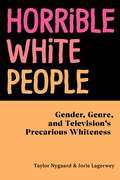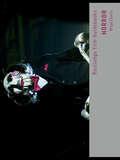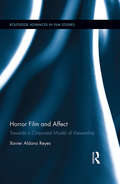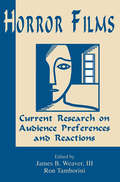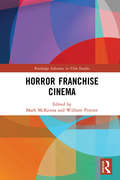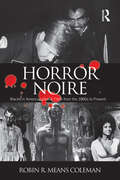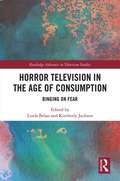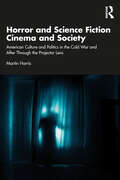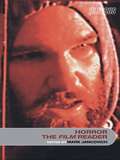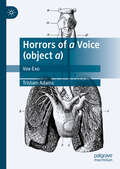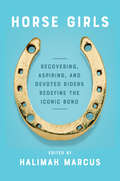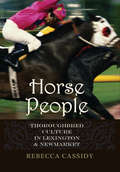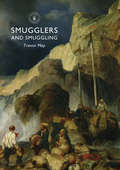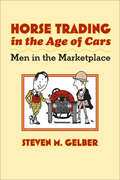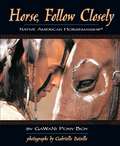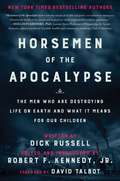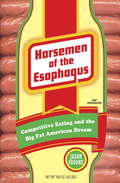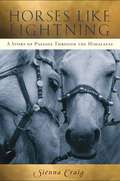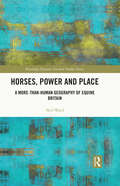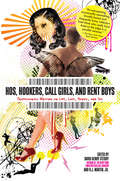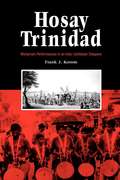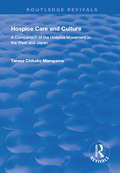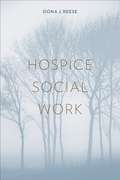- Table View
- List View
Horrible White People: Gender, Genre, and Television's Precarious Whiteness
by Taylor Nygaard Jorie LagerweyExamines the bleak television comedies that illustrate the obsession of the white left with its own anxiety and sufferingAt the same time that right-wing political figures like Donald Trump were elected and reactionary socio-economic policies like Brexit were voted into law, representations of bleakly comic white fragility spread across television screens. American and British programming that featured the abjection of young, middle-class, liberal white people—such as Broad City, Casual, You’re the Worst, Catastrophe, Fleabag, and Transparent—proliferated to wide popular acclaim in the 2010s. Taylor Nygaard and Jorie Lagerwey track how these shows of the white left, obsessed with its own anxiety and suffering, are complicit in the rise and maintenance of the far right—particularly in the mobilization, representation, and sustenance of structural white supremacy on television.Nygaard and Lagerwey examine a cycle of dark television comedies, the focus of which are “horrible white people,” by putting them in conversation with similar upmarket comedies from creators and casts of color like Insecure, Atlanta, Dear White People, and Master of None. Through their analysis, they demonstrate the ways these non-white-centric shows negotiate prestige TV’s dominant aesthetics of whiteness and push back against the centering of white suffering in a time of cultural crisis.Through the lens of media analysis and feminist cultural studies, Nygaard and Lagerwey’s book opens up new ways of looking at contemporary television consumption—and the political, cultural, and social repercussions of these “horrible white people” shows, both on- and off-screen.
Horror (Routledge Film Guidebooks)
by Brigid CherryHorror cinema is a hugely successful, but at the same time culturally illicit genre that spans the history of cinema. It continues to flourish with recent cycles of supernatural horror and torture porn that span the full range of horror styles and aesthetics. It is enjoyed by audiences everywhere, but also seen as a malign influence by others. In this Routledge Film Guidebook, audience researcher and film scholar Brigid Cherry provides a comprehensive overview of the horror film and explores how the genre works. Examining the way horror films create images of gore and the uncanny through film technology and effects, Cherry provides an account of the way cinematic and stylistic devices create responses of terror and disgust in the viewer. Horror examines the way these films construct psychological and cognitive responses and how they speak to audiences on an intimate personal level, addressing their innermost fears and desires. Cherry further explores the role of horror cinema in society and culture, looking at how it represents various identity groups and engages with social anxieties, and examining the way horror sees, and is seen by, society.
Horror Film and Affect: Towards a Corporeal Model of Viewership (Routledge Advances in Film Studies)
by Xavier Aldana ReyesThis book brings together various theoretical approaches to Horror that have received consistent academic attention since the 1990s – abjection, disgust, cognition, phenomenology, pain studies – to make a significant contribution to the study of fictional moving images of mutilation and the ways in which human bodies are affected by those on the screen on three levels: representationally, emotionally and somatically. Aldana Reyes reads Horror viewership as eminently carnal, and seeks to articulate the need for an alternative model that understands the experience of feeling under corporeal threat as the genre’s main descriptor. Using recent, post-millennial examples throughout, the book also offers case studies of key films such as Hostel, [REC], Martyrs or Ginger Snaps, and considers contemporary Horror strands such as found footage or 3D Horror.
Horror Films: Current Research on Audience Preferences and Reactions (Routledge Communication Series)
by Iii James B. Weaver Ron TamburiniWhy do so many of us enjoy being told frightening stories? What are some of the consequences that result from such exposure? In light of the considerable popularity of horror films over the last three decades, these questions have become the focus of growing attention for many scholars. However, research on audience preferences for, and reactions to, horror films has been performed eclectically by investigators from varied theoretical and methodological backgrounds. As a result, the information has not been effectively integrated. This volume was written to address this problem and to position the study of audience responses to frightening fiction as a significant research topic.
Horror Franchise Cinema (Routledge Advances in Film Studies)
by Mark McKennaThis book explores horror film franchising from a broad range of interdisciplinary perspectives and considers the horror film’s role in the history of franchising and serial fiction. Comprising 12 chapters written by established and emerging scholars in the field, Horror Franchise Cinema redresses critical neglect toward horror film franchising by discussing the forces and factors governing its development across historical and contemporary terrain while also examining text and reception practices. Offering an introduction to the history of horror franchising, the chapters also examine key texts including Universal Studio monster films, Blumhouse production films, The Texas Chainsaw Massacre, A Nightmare on Elm Street, Alien, I Spit on Your Grave, Let the Right One In, Italian zombie films, anthology films, and virtual reality. A significant contribution to studies of horror cinema and film/media franchising from the 1930s to the present day, this book will be of interest to students and scholars of film studies, media and cultural studies, franchise studies, political economy, audience/reception studies, horror studies, fan studies, genre studies, production cultures, and film histories.
Horror Noire: Blacks in American Horror Films from the 1890s to Present
by Robin R Means ColemanFrom King Kong to Candyman, the boundary-pushing genre of the horror film has always been a site for provocative explorations of race in American popular culture. In Horror Noire: Blacks in American Horror Films from 1890's to Present, Robin R. Means Coleman traces the history of notable characterizations of blackness in horror cinema, and examines key levels of black participation on screen and behind the camera. She argues that horror offers a representational space for black people to challenge the more negative, or racist, images seen in other media outlets, and to portray greater diversity within the concept of blackness itself. Horror Noire presents a unique social history of blacks in America through changing images in horror films. Throughout the text, the reader is encouraged to unpack the genre’s racialized imagery, as well as the narratives that make up popular culture’s commentary on race. Offering a comprehensive chronological survey of the genre, this book addresses a full range of black horror films, including mainstream Hollywood fare, as well as art-house films, Blaxploitation films, direct-to-DVD films, and the emerging U.S./hip-hop culture-inspired Nigerian "Nollywood" Black horror films. Horror Noire is, thus, essential reading for anyone seeking to understand how fears and anxieties about race and race relations are made manifest, and often challenged, on the silver screen.
Horror Television in the Age of Consumption: Binging on Fear (Routledge Advances in Television Studies)
by Kimberly Jackson Linda BelauCharacterized as it is by its interest in and engagement with the supernatural, psycho-social formations, the gothic, and issues of identity and subjectivity, horror has long functioned as an allegorical device for interrogations into the seamier side of cultural foundations. This collection, therefore, explores both the cultural landscape of this recent phenomenon and the reasons for these television series’ wide appeal, focusing on televisual aesthetics, technological novelties, the role of adaptation and seriality, questions of gender, identity and subjectivity, and the ways in which the shows’ themes comment on the culture that consumes them. Featuring new work by many of the field’s leading scholars, this collection offers innovative readings and rigorous theoretical analyses of some of our most significant contemporary texts in the genre of Horror Television.
Horror and Science Fiction Cinema and Society: American Culture and Politics in the Cold War and After Through the Projector Lens
by Martin HarrisExamining how horror and science fiction films from the 1950s to the present invent and explore fictional “us-versus-them” scenarios, this book analyzes the different ways such films employ allegory and/or satire to interrogate the causes and consequences of increasing polarization in American politics and society.Starting with the killer ants film with an anti-communist subtext Them! (1954) and concluding with Jordan Peele’s social horror film with revenge-seeking homicidal doppelgängers Us (2019), Martin Harris highlights social and political contexts, contemporary reviews and responses, and retrospective evaluations to show how American horror and science fiction films reflect and respond to contemporary conflicts marking various periods in U.S. history from post-WWII to the present, including those concerning race, gender, class, faith, political ideology, national identity, and other elements of American society.Horror and Science Fiction Cinema and Society draws upon cinematic sociology to provide a resourceful approach to American horror and science fiction films that integrates discussion of plot construction and character development with analyses of the thematic uses of conflict, guiding readers’ understanding of how filmmakers create otherworldly confrontations to deliver real-world social and political commentary.
Horror in Architecture: The Reanimated Edition
by Joshua Comaroff Ong Ker-ShingA new edition of this extensive visual analysis of horror tropes and their architectural analogues Horror in Architecture presents an unflinching look at how horror genre tropes manifest in the built environment. Spanning the realms of art, design, literature, and film, this newly revised and expanded edition compiles examples from all areas of popular culture to form a visual anthology of the architectural uncanny. Rooted in the Romantic and Gothic treatment of horror as a serious aesthetic category, Horror in Architecture establishes incisive links between contemporary horror media and its parallel traits found in various architectural designs. Through chapters dedicated to distorted and monstrous buildings, abandoned spaces, extremes of scale, and other structural peculiarities, and featuring new essays on insurgent natures, blobs, and architectural puppets, this volume brings together diverse architectural anomalies and shows how their unsettling effects deepen our fascination with the unreal. Intended for both horror fans and students of visual culture, Horror in Architecture turns a unique lens on the relationship between the human body and the artificial landscapes it inhabits. Extensively illustrated with photographs, film stills, and diagrams, this book retrieves horror from the cultural fringes and demonstrates how its attributes permeate the modern condition and the material world.
Horror, The Film Reader (In Focus: Routledge Film Readers)
by Mark JancovichHorror, The Film Reader brings together key articles to provide a comprehensive resource for students of horror cinema. Mark Jancovich's introduction traces the development of horror film from The Cabinet of Dr. Caligari to The Blair Witch Project, and outlines the main critical debates. Combining classic and recent articles, each section explores a central issue of horror film, and features an editor's introduction outlining the context of debates.
Horrors of a Voice (object a): Vox-Exo
by Tristam AdamsThis book reframes the Lacanian object a voice as a horrific register of alterity. The object gaze has received, as it does in Jacques Lacan’s work, more commentary than voice. Yet recently voice has garnered interest from multiple disciplines. The book intervenes in the Slovenian school’s commentary of the ‘object voice’ in terms of two questions: audition and corporeality. This intervention synthesizes psychoanalysis with recent theorizing of the horror of philosophy. In this intervention the object a voice is argued to resonate in lacunae – epistemological voids that evoke horror in the subject. Biological and evolutionary perspectives on voice, genre horror film and literature, music videos, close readings of Freudian and Lacanian case studies and textual analysis of ancient philosophy texts all contribute to an elucidation of the horrors of the object a voice: Vox-Exo.
Horse Girls: Recovering, Aspiring, and Devoted Riders Redefine the Iconic Bond
by Halimah Marcus“A wild, rollicking ride into the heart of horse country—these essays get at what it means to love horses, in all that love's complexity.” —Anton DiSclafani, author of The Yonahlossee Riding Camp for GirlsA compelling and provocative essay collection that smashes stereotypes and redefines the meaning of the term “horse girl,” broadening it for women of all cultural backgrounds.As a child, horses consumed Halimah Marcus’ imagination. When she wasn’t around horses she was pretending to be one, cantering on two legs, hands poised to hold invisible reins. To her classmates, girls like Halimah were known as “horse girls,” weird and overzealous, absent from the social worlds of their peers. Decades later, when memes about “horse girl energy,” began appearing across social media—Halimah reluctantly recognized herself. The jokes imagine girls as blinkered as carriage ponies, oblivious to the mockery behind their backs. The stereotypical horse girl is also white, thin, rich, and straight, a daughter of privilege. Yet so many riders don’t fit this narrow, damaging ideal, and relate to horses in profound ways that include ambivalence and regret, as well as unbridled passion and devotion.Featuring some of the most striking voices in contemporary literature—including Carmen Maria Machado, Pulitzer-prize winner Jane Smiley, T Kira Madden, Maggie Shipstead, and Courtney Maum—Horse Girls reframes the iconic bond between girls and horses with the complexity and nuance it deserves. And it showcases powerful emerging voices like Braudie Blais-Billie, on the connection between her Seminole and Quebecois heritage; Sarah Enelow-Snyder, on growing up as a Black barrel racer in central Texas; and Nur Nasreen Ibrahim, on the colonialist influence on horse culture in Pakistan.By turns thought-provoking and personal, Horse Girls reclaims its titular stereotype to ask bold questions about autonomy and desire, privilege and ambition, identity and freedom, and the competing forces of domestication and wildness.
Horse People: Thoroughbred Culture in Lexington and Newmarket (Animals, History, Culture)
by Rebecca Louise CassidyThe world of Thoroughbred racing is glamorous, secretive, dangerous, and seductive—the sport of kings and the poor man's obsession. While the spectacle of racing stirs the imagination, it belies the ruthless business that lies beneath.This engaging original study demystifies this complex world by comparing centers of excellence in Britain and North America. Drawing from intensive field work in Suffolk's Newmarket and Kentucky's Lexington, Rebecca Cassidy gives us the inside track on all players in the industry—from the elite breeders and owners to the stable boys, racetrack workers, and veterinarians. She leads us through horse farms, breeding barns, and yearling sales; explains rigorous training regimens; and brings us trackside on race day.But the history of Thoroughbred racing culture is more than a collection of fascinating characters and exciting events. Cassidy's investigation reveals the factors—ethical, cultural, political, and economic—that have shaped the racing tradition.
Horse Racing in Britain and Ireland
by Anne HollandHistorian and experienced rider Anne Holland explores the history of horse racing, from the horses and jockeys, the history and racecourses, to betting and race-goers. The "Sport of Kings," racing dates back to contests between chariots at the ancient Olympics. Racing came to Britain with the Romans, and its popularity, particularly among the elite, led to the creation of the thoroughbred racehorse; and the establishment of a racing calendar with flat races and steeple chases at a plethora of dedicated racecourses around the country. Attending the races is a social activity no longer restricted to the elite, to the point that some racegoers enjoy a day out without every turning to watch the horses race by.
Horse Trading in the Age of Cars: Men in the Marketplace (Gender Relations in the American Experience)
by Steven M. GelberThe trading, selling, and buying of personal transport has changed little over the past one hundred years. Whether horse trading in the early twentieth century or car buying today, haggling over prices has been the common practice of buyers and sellers alike. Horse Trading in the Age of Cars offers a fascinating study of the process of buying an automobile in a historical and gendered context. Steven M. Gelber convincingly demonstrates that the combative and frequently dishonest culture of the showroom floor is a historical artifact whose origins lie in the history of horse trading. Bartering and bargaining were the norm in this predominantly male transaction, with both buyers and sellers staking their reputations and pride on their ability to negotiate the better deal. Gelber comments on this point-of-sale behavior and what it reveals about American men. Gelber's highly readable and lively prose makes clear how this unique economic ritual survived into the industrial twentieth century, in the process adding a colorful and interesting chapter to the history of the automobile.
Horse, Follow Closely
by Gawani Pony BoyThe bible of North American Horsemanship, Horse, Follow Closely is GaWaNi Pony Boy's signature title about the relationship training methods that are steeped in common sense and the age-old wisdom of his Native American ancestors. Of mixed blood Tsa-la-gi, GaWaNi Pony Boy was able to conceive his philosophy and compile the methods of relationship training while touring the United States with a Native American drum band and consulting the Tribal Elders from many different nations and backgrounds. The methods and beliefs of relationship training come directly from the first great horsemen of North America. "Horse and rider are one. Theirs is a relationship of trust, harmony, and respect born of a way of life that is all but lost." The stunning full-color photographs by Gabrielle Boiselle capture Pony Boy's serenity and unity with his close horse companions. The author's simple eloquence forges a deep, profound relationship with his readers that few books ever hope to achieve. As Pony Boy writes in the introduction, "For many [the Native American horseman] represents the ultimate rider. The essence of a horseman, both his skill and intuition, goes beyond the hours he spends in the saddle....the folklore of every Native tribe are stories, tales, and beliefs to exemplify human's relations to other animals." The book begins with an analysis of how horses came to live with the Natives of North America and horses' impact on Native life. The crux of relationship training, according to the author, is to understand "what it means to be a horse, react like a horse, and relate to other things like a horse...." Native Americans were able to create such strong relationship with horses in a short time because they understood that "a horse is a horse." Learning to balance the relationship between horse and human is the missing link to becoming a masterful horseman or horsewoman. The book describes not only the techniques involved for relationship training but also the belief system and attitude that must be applied to all methods of horsemanship.In addition to presenting the methods and philosophy of relationship training, Horse, Follow Closely also includes many stories and legends of Native Americans and their horses, all of which teach the reader something new about himself and his relationship with his horse.
Horsemen of the Apocalypse: The Men Who Are Destroying the Planet—And How They Explain Themselves to Their Own Children
by David Talbot Dick Russell Robert F. Kennedy Jr.The science is overwhelming; the facts are in. The planet is heating up at an alarming rate and the results are everywhere to be seen. Yet, as time runs out, climate progress is blocked by the men who are profiting from the burning of the planet: energy moguls like the Koch brothers and Exxon Mobil CEO Rex Tillerson. Powerful politicians like Senators Mitch McConnell and Jim Inhofe, who receive massive contributions from the oil and coal industries. Most of these men are too intelligent to truly believe that climate change is not a growing crisis. And yet they have put their profits and careers ahead of the health and welfare of the world’s population?and even their own children and grandchildren. How do they explain themselves to their offspring, to the next generations that must deal with the environmental havoc that these men have wreaked? Horsemen of the Apocalypse takes a personal look at this global crisis, literally bringing it home.
Horsemen of the Esophagus: Competitive Eating and the Big Fat American Dream
by Jason Fagone"To be up on stage, shoving food in your face, beats everyday existence for most people." --David "Coondog" O'Karma, competitive eater"Hungry" Charles Hardy. Ed "Cookie" Jarvis. Sonya "The Black Widow" Thomas. Joey "Jaws" Chestnut. Will such names one day be looked back upon as the pioneers of a new manifestation of the irrepressible American appetite for competition, money, fame, and self-transformation? They will if the promoters of the newly emerging sport of competitive eating have their way. In Horsemen of the Esophagus, Jason Fagone reports on the year he spent in the belly of this awakening beast.Fagone's trek takes him to 27 eating contests on two continents, from the World Grilled Cheese Eating Championship in Venice Beach, California, to Nagoya, Japan, where he pursues an interview with the legendary Takeru Kobayashi, perhaps the most prodigious eater in the world today, and to the Nathan's Famous Hot Dog Eating Contest at Coney Island, the sport's annual grand finale, where Kobayashi has eaten more than 50 dogs in 12 minutes. Along the way, Fagone discovers an absurd, sometimes troubling subculture on the make, ready to bust out of its county fair and neighborhood-fat-guys niche and grab a juicy piece of the big-time television sports/Vegas spectacle jackpot. Fagone meets promoters like George Shea, the P. T. Barnum of the International Federation of Competitive Eating (aka IFOCE, "the governing body of all stomach-centric sport") and enters the lives of three "gurgitators": David "Coondog" O'Karma, a fiftyish, six-two house painter from Ohio who's "not ready to become invisible"; Bill "El Wingador" Simmons, the Philly Wing Bowl legend who is shooting for a fifth chicken-eating championship despite the fact that it may be killing him; and Tim "Eater X" Janus, a lean young Wall Street trader who takes a seriously scientific and athletic approach to the pursuit of ingesting mountains of food in record-breaking times. Each in his own way feels as if he has lost or not yet found something essential in life, and each is driven by the desperate hope that through consumption he may yet find redemption, that even in the junkiest of America's junk culture, true nourishment might be found. After all, as it says on the official IFOCE seal: In Voro Veritas (In Gorging, Truth).With forays into the gastrointestinal mechanics of the alimentary canal ("it's what unbuilds the world to build you," but, hey, you can skip that part if you like), the techniques and tricks of the experienced gurgitators (pouring a little club soda on top of high-carb foods makes them easier to swallow), and the historical roots of the competitive eating phenomenon, Horsemen of the Esophagus gives the French something else to dislike about America. And it gives the rest of us food for thought about the bizarre and unlikely places the American Dream can sometimes lead.Also available as an eBookFrom the Hardcover edition.
Horses Like Lightning: A Story of Passage Through the Himalayas
by Sienna CraigA tender account - by turns cultural exploration and memoir of a young woman's firsthand experience of change and continuity in one of the worlds most remote regions, through the lens of the horse and "horse culture."At nineteen, Sienna Craig made her first venture deep into Mustang, an ethnically Tibetan area of Nepal, in the rainshadow of the Himalayas. As an equestrian and a buddhing anthropologist, she sought not only to understand what it was like to rely on horses to navigate through the windswept valleys and plains of High Asia, but also to grasp how horses lent meaning to the lives of the Mustangi people. Through living and working with local Tibetan doctors, veterinarians, and other horse experts, as well as the deep friendships she formed, Sienna began to understand the region's history, and the way life in Mustang was being transformed in the face of temendous social, political, and economic shifts. She learned much about herself and her life's course through her year in Mustang - a place that came to feel, for all its foreignness, like home.
Horses, Power and Place: A More-Than-Human Geography of Equine Britain (Routledge Human-Animal Studies Series)
by Neil WardHorses, Power and Place explores the evolution of humanity’s relationship with horses, from early domestication through to the use of the horse as a draught animal, an agricultural, industrial and military asset, and an animal of sport and leisure. Taking an historical approach, and using Britain as a case study, this is the first book-length exploration of the horse in the more-than-human geography of a nation. It traces the role and implications of horse-based mobility for the evolution of settlement structure, urban morphology and the rural landscape. It maps the growth and various uses of horses to the point of ‘peak horse’ in the early twentieth century before considering the contemporary place of the horse in twenty-first century economy and society. It assesses the role of the horse in the formation of places within Britain and in the formation of the nation. The book reflects on the implications of this historical and contemporary equine geography for animal geographies and animal studies. It argues for the study of animals in general in how places are made, not just by humans. Written in a clear and accessible style, this book will be essential reading for students and scholars of animal geography and animal studies more widely.
Hos, Hookers, Call Girls, and Rent Boys: Professionals Writing on Life, Love, Money, and Sex
by R. J. Martin Jr. David Henry SterryThe only thing the writers in this book have in common is that they've exchanged sex for money. They're PhDs and dropouts, soccer moms and jailbirds, $2,500-a-night call girls and $10 crack hos, and everything in between. This anthology lends a voice to an underrepresented population that is simultaneously reviled and worshipped.Hos, Hookers, Call Girls, and Rent Boys is a collection of short memoirs, rants, confessions, nightmares, journalism, and poetry covering life, love, work, family, and yes, sex. The editors gather pieces from the world of industrial sex, including contributions from art-porn priestess Dr. Annie Sprinkle, best-selling memoirist David Henry Sterry (Chicken: Self-Portrait of a Young Man for Rent), sex activist and musical diva Candye Kane, women and men right off the streets, girls participating in the first-ever National Summit of Commercially Sexually Exploited Youth, and Ruth Morgan Thomas, one of the organizers of the European Sex Work, Human Rights, and Migration Conference.Sex is a billion-dollar industry. Meet the real people who are its flesh and blood.
Hosay Trinidad: Muharram Performances in an Indo-Caribbean Diaspora
by Frank J. KoromThe multivocalic rite known as Hosay in the Caribbean developed out of earlier practices originating in Iraq and Iran which diffused to Trinidad by way of South Asian indentured laborers brought to the Caribbean by the British from the mid-1800s to the early decades of the twentieth century. The rituals are important as a Shi'i religious observance, but they also are emblems of ethnic and national identity for Indo-Trinidadians. Frank Korom investigates the essential role of Hosay in the performance of multiple identities by historically and ethnographically situating the event in Middle Eastern, South Asian, and Caribbean contexts. Hosay Trinidad: Muharram Performances in an Indo-Caribbean Diaspora is the first detailed historical and ethnographic study of Islamic muharram rituals performed on the island of Trinidad.Korom's central argument is that the annual rite is a polyphonic discourse that is best understood by employing multiple levels of interpretation. On the symbolic level the observance provides esoteric meaning to a small community of Indo-Trinidadian Muslims. On another level, it is perceived to be representative of "transplanted" Indian culture as a whole. Finally, the rituals are becoming emblematic of Trinidad's polyethnic population. Addressing strategies used to resist integration and assimilation, Hosay Trinidad is engaged with theories concerning the notion of cultural creolization in the Caribbean as well as in the general study of global diasporas.
Hospice Care and Culture: A Comparison of the Hospice Movement in the West and Japan (Routledge Revivals)
by Teresa Chikako MaruyamaFirst published in 1999, Maruyama explores some significant difficulties and differences in bringing the western hospice philosophy to the Japanese medical culture. Whilst not giving any definite answers, this study determines what some of the critical questions that need to be considered into Japanese medicine, as Mayuyama argues without defining these questions to begin with we cannot find appropriate solutions.
Hospice Social Work
by Dona J ReeseThis is the first book to explore the history, characteristics, and challenges of hospice social work, incorporating leading research into an underlying framework for practice and care. A longtime hospice social work practitioner, Dona J. Reese describes the hospice social work role in assessment and intervention with individuals, families, groups, organizations, and the community, while honestly confronting the personal and professional difficulties of such life-changing work. She introduces a well-tested model of psychosocial and spiritual variables that predict hospice client outcomes, and she advances a social work assessment tool that documents their occurrence. Operating at the center of national leaders' coordinated efforts to develop and advance professional organizations and guidelines for end-of-life care, Reese reaches out with support and practice information, helping social workers understand their significance in treating the whole person, contributing to the cultural competence of hospice settings, and claiming a definitive place within the hospice team.
Hospice Social Work (End-of-Life Care: A Series)
by Dona ReeseThe first text to explore the history, characteristics, and challenges of hospice social work, this volume weaves leading research into an underlying framework for practice and care. A longtime practitioner, Dona J. Reese describes the hospice social work role in assessment and intervention with individuals, families, groups, organizations, and the community, while honestly confronting the personal and professional difficulties of such life-changing work. She introduces a well-tested model of psychosocial and spiritual variables that predict hospice client outcomes, and she advances a social work assessment tool to document their occurrence. Operating at the center of national leaders' coordinated efforts to develop and advance professional organizations and guidelines for end-of-life care, Reese reaches out with support and practice information, helping social workers understand their significance in treating the whole person, contributing to the cultural competence of hospice settings, and claiming a definitive place within the hospice team.
